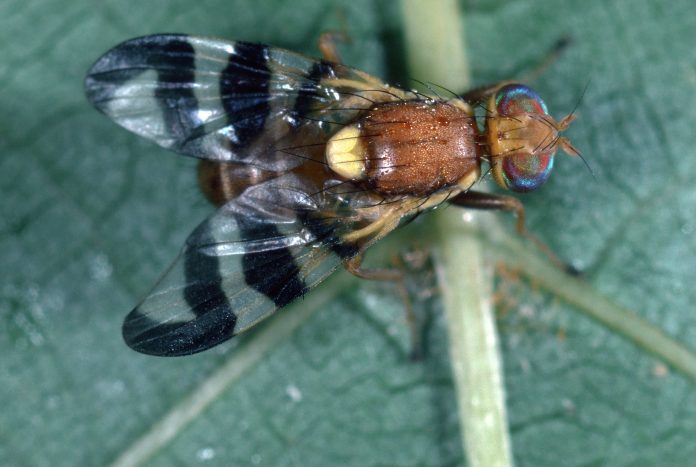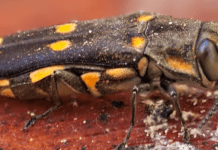
A UCCE Tree and Vine IPM meeting in Modesto in June presented growers with the results of recent walnut husk fly research on new monitoring lure trials and bait efficacy. The walnut husk fly, which lays its eggs below the surface of the walnut husk, does the most damage to crops through nutshell staining, which can be a big problem for commercial growers who sell their product in-shell. An early season infestation can also result in shriveled, moldy kernels.
Monitoring of walnut husk fly typically begins in mid-June and continues through September or until husk split when the fly damage is no longer an issue, according to Bob Van Steenwyk, entomologist at UC Berkeley, who presented his team’s findings to about 30 people at the meeting.
The size of a housefly, the walnut husk fly dons colorful, spotted wings. Females are slightly larger in size than males, have a pointed abdomen with an ovipositor, and straw-colored first leg segments. A male’s first leg segment will be brown or black.
Controlling Females
Monitoring for pregnant females is the best way to control walnut husk fly, Van Steenwyk explained, noting the technique to determine if a female has eggs is by dissecting or squeezing on her abdomen; if she has eggs, then you need to treat.
“The whole idea for the insecticide control is to kill the females before oviposition,” he said. “After oviposition, there’s only one, maybe two materials that can have any impact on the young larvae in the husk.”
UC research being done to monitor walnut husk fly more efficiently has seen some recent promising results. There could even be a new pheromone lure available at some point soon for growers, according to Van Steenwyk. The new pheromone was published by a French researcher in 2000 and Van Steenwyk’s group started work on the pheromone last year.
The research group had very little information about how long the pheromone lasted, how much to put in the lure, or even what type of lure to use.
“Last year we did a lot of exploring,” he said, “but it does look like the pheromone will increase your fly catch.”
Commercial Lures
Studies with 100 mg of hexalactone, heptalactone and a combination of both in polymeric plug lures have been evaluated with Trécé yellow sticky panel traps compared to ammonium bicarbonate lures and blank traps. The study also compared the French septa lures containing 50 mg of hexalactone, heptalactone and a combination of both.
The studies were conducted in Hilmar, Calif., which had a very high population of the fly, and in Patterson, Calif., where a standard population exists. Van Steenwyk added Alpha Scents and a French company are currently working to develop a commercial lure and he is hopeful Trécé will also work with them as they move forward.
Results from the study showed the combination of the hexalactone lure and ammonium bicarbonate lure in the same trap was more effective than either when used alone. While researchers on the trial are enthusiastic about the findings, Van Steenwyk said it is important to remember the trial is still in the very early stages of research.
“We don’t want to get people too excited for it right now because we’re just in the second year of research on it, and we don’t know how important it’s going to be for growers, but we are excited. It’s something very unique,” he said.
The lure project is funded by the California Walnut Board, and the team hopes to have the study wrapped up this year and progress to grower/PCA evaluation the following year.
Bait Efficacy
Another focus for Van Steenwyk’s team has been on bait efficacy for walnut husk fly and researching various methods to find the most economical yet effective bait for growers. He said as they were beginning to develop new baits several years ago, they discovered mixing a very small amount of GF-120 Naturalyte Fruit Fly Bait, a nitrogen source, with molasses worked well to boost fly catch. They also realized using urea in the bait as a nitrogen source may also boost fly catch. Urea is commonly used by growers as a foliar nitrogen application.
A study conducted last year on olive fruit fly in Napa showed a mixture of granulated white sugar, Nu-Lure, Brandt Insect Bait and water worked quite well, Van Steenwyk explained.
“We made this witch’s brew and it worked fantastic,” he said, adding the Nu-Lure and Brandt Insect Bait provides a nitrogen source.
Following the Napa study, they began work this year to produce a new bait to be composed of molasses or sugar, Nu-Lure, Brandt Insect Bait and urea. Van Steenwyk shared the preliminary results of the study, which was conducted by setting up a box with a target filter paper dipped in the test solution in the center of the box containing a walnut husk fly and two cameras filming. Data collected in the study was the result of monitoring in 15- to 30-minute increments to observe how many flies landed and how long they stayed.
Van Steenwyk stated that the sex of the flies, their age and the feeding state caused huge variances in their results.
“It makes a heck of a lot of difference if you have male or female flies, your flies have been previously fed, if they’re old or young flies,” he explained. “You get different results depending on your experimental design.”
However, based on early results it appears the addition of urea to the bait may result in increased feeding by the flies.
As the research on baits continues, Van Steenwyk said they eventually hope to have more extensive data that might help growers save money.
“Hopefully next year we’ll have some more data to say you can change your baits to something cheaper that will work better,” he said.










